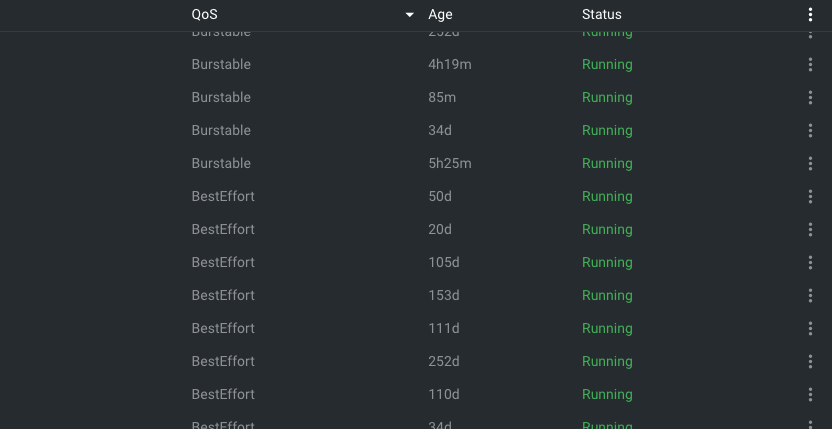In the world of Kubernetes, Quality of Service (QoS) plays a vital role in ensuring optimal resource allocation and performance. Kubernetes offers three distinct QoS classes: Guaranteed, Burstable, and BestEffort.

Guaranteed QoS Class
The Guaranteed QoS class is the highest priority class in Kubernetes. Pods assigned to this class are guaranteed the requested CPU and memory resources, which are reserved exclusively for them. This ensures that the pod will not be evicted due to resource constraints, providing predictable and reliable performance. Guaranteed QoS is typically suitable for critical workloads such as databases or other important system components.
A Pod is Guaranteed if and only if:
- Every container in the Pod has:
cpurequest AND limit setmemoryrequest AND limit set
- AND for both resources:
requests == limits
Example:
resources:
requests:
cpu: "500m"
memory: "512Mi"
limits:
cpu: "500m"
memory: "512Mi"If any container breaks this rule → not Guaranteed.
Key characteristics:
- Exclusive resource allocation for pods.
- Pods are guaranteed to have the requested resources available at all times.
- Pods are prioritised over other QoS classes when it comes to resource allocation.
Best practices:
- Specify accurate resource requests and limits to ensure efficient utilisation.
- Regularly monitor and adjust resource requests based on workload behavior.
- Avoid overcommitting resources to prevent potential resource exhaustion.
apiVersion: v1
kind: Pod
metadata:
name: critical-pod
spec:
containers:
- name: app
image: my-critical-app
resources:
requests:
memory: "1Gi"
cpu: "500m"
limits:
memory: "1Gi"
cpu: "500m"In this example, the “critical-pod” is assigned to the Guaranteed QoS class. The pod specifies resource requests and limits for both memory and CPU, ensuring that it receives the requested resources exclusively.
Burstable QoS Class
The Burstable QoS class is the intermediate class in Kubernetes, providing a balance between resource guarantees and flexibility. Pods assigned to this class receive the requested resources, but they can also consume additional resources when available. However, if the cluster faces resource contention, pods in the Burstable class may be evicted to free up resources for higher priority pods.
A Pod is Burstable if:
- At least one container has a request or limit set
- BUT requests ≠ limits for CPU or memory
Examples:
requests:
cpu: 200m
limits:
cpu: 1000mor
requests:
memory: 512Mi
limits:
memory: 1GiMost real workloads (Kafka, web apps) are Burstable.
Key characteristics:
- Pods receive the requested resources but can consume additional resources when available.
- Pods can be evicted if resource contention occurs.
Best practices:
- Set appropriate resource requests and limits to allow flexibility while preventing excessive resource consumption.
- Implement resource quotas to avoid excessive resource usage by pods in this class.
- Monitor resource utilization regularly to ensure efficient resource allocation.
apiVersion: v1
kind: Pod
metadata:
name: burstable-pod
spec:
containers:
- name: app
image: my-burstable-app
resources:
requests:
memory: "512Mi"
cpu: "250m"
limits:
memory: "1024Mi"
cpu: "500m"In this example, the “burstable-pod” is assigned to the Burstable QoS class. The pod specifies resource requests for memory and CPU, allowing flexibility for additional resource consumption if available, but there are no explicit limits defined.
BestEffort QoS Class
The BestEffort QoS class is the lowest priority class in Kubernetes. Pods in this class have no resource guarantees and can consume any available resources within the cluster. They are the first to be evicted if the cluster faces resource constraints. BestEffort is often used for non-critical or low-priority workloads where resource guarantees are not essential.
A Pod is BestEffort if:
- No CPU or memory requests or limits are set at all
Key characteristics:
- No resource guarantees for pods.
- Pods can consume any available resources within the cluster.
- Pods are the first to be evicted if resource contention occurs.
Best practices:
- Use BestEffort for non-critical workloads or tasks with low resource requirements.
- Avoid relying on pods in this class for important system components.
- Regularly monitor resource usage to identify potential resource bottlenecks.
apiVersion: v1
kind: Pod
metadata:
name: besteffort-pod
spec:
containers:
- name: app
image: my-besteffort-appIn this example, the “besteffort-pod” is assigned to the BestEffort QoS class. The pod does not specify any resource requests or limits, allowing it to consume any available resources within the cluster.
By appropriately assigning pods to the appropriate QoS class, you can strike a balance between resource guarantees and flexibility, allowing your cluster to handle various workloads effectively.
